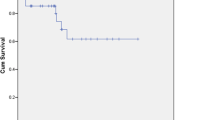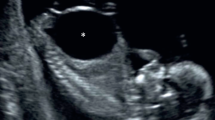Abstract
Observation is a conservative management option in infants with nonrefluxing hydronephrosis, primary nonrefluxing megaureter and ureterocele diagnosed postnatally following antenatal detection of hydronephrosis. Antibiotic prophylaxis might be a sensible regimen under these circumstances to prevent UTI in this population who are potentially at increased risk. However, studies examining the efficacy of prophylactic antibiotics are sparse in this setting. For each condition, prophylactic policies seem extremely variable, and UTI rates vary widely with comparable rates reported between patients followed on and off antibiotics. Overall, antibiotic prophylaxis seems unnecessary in patients with isolated low-grade hydronephrosis. Patients with high-grade nonrefluxing hydronephrosis seem at increased risk of UTI, with risk further increasing in patients with associated ureteral dilatation (hydroureteronephrosis) irrespective of the presence of a ureterocele. Obstruction might be an additional independent risk factor, but the diagnosis of obstruction is often possible only in retrospect. The data available suggest that infants are the most at risk of UTI during the first 6 months of life, particularly if they undergo catheterization during workup examinations. Thus, antibiotic prophylaxis might be prudent during the first 6–12 months of life in patients with high-grade hydronephrosis and hydroureteronephrosis with or without ureterocele, and particularly before completion of the diagnostic workup. Paediatric urologists are urged to embark on controlled trials to compare patients followed with and without antibiotic prophylaxis.
Key Points
-
Evidence supporting the use of antibiotic prophylaxis to prevent UTI in infants with nonrefluxing upper tract dilatations or ureterocele is inconclusive
-
Reported infection rates vary widely and are comparable in patients receiving prophylaxis and those who are not
-
The prescription of antibiotic prophylaxis for UTI seems to be influenced by the local medical standards, physician experience and the likelihood of prescribing postnatal investigations
-
Antibiotic prophylaxis can be avoided in patients with low-grade hydronephrosis and no ureteral dilatation
-
Patients with high grades of hydronephrosis are at increased risk of UTI; a dilated ureter increases the risk, whereas the presence of ureterocele does not
-
Infants are most at risk in the first 6 months of life, and catheterization performed during work-up might trigger the infection
This is a preview of subscription content, access via your institution
Access options
Subscribe to this journal
Receive 12 print issues and online access
$209.00 per year
only $17.42 per issue
Buy this article
- Purchase on Springer Link
- Instant access to full article PDF
Prices may be subject to local taxes which are calculated during checkout





Similar content being viewed by others
References
Blyth, B., Snyder, H. M. & Duckett, J. W. Antenatal diagnosis and subsequent management of hydronephrosis. J. Urol. 149, 693–698 (1993).
Gunn, T. R., Mora, J. D. & Pease, P. Antenatal diagnosis of urinary tract abnormalities by ultrasonography after 28 weeks' gestation: incidence and outcome. Am. J. Obstet. Gynecol. 172, 479–486 (1995).
Livera, L. N., Brookfield, D. S., Egginton, J. A. & Hawnaur, J. M. Antenatal ultrasonography to detect fetal renal abnormalities: a prospective screening programme. BMJ 298, 1421–1423 (1989).
Sairam, S., Al-Habib, A., Sasson, S. & Thilaganathan, B. Natural history of fetal hydronephrosis diagnosed on mid-trimester ultrasound. Ultrasound Obstet. Gynecol. 17, 191–196 (2001).
Queisser-Luft, A., Stolz, G., Wiesel, A., Schlaefer, K. & Spranger, J. Malformations in newborn: results based on 30,940 infants and fetuses from the Mainz congenital birth defect monitoring system (1990–1998). Arch. Gynecol. Obstet. 266, 163–167 (2002).
Wiesel, A., Queisser-Luft, A., Clementi, M., Bianca, S. & Stoll, C. EUROSCAN Study Group. Prenatal detection of congenital renal malformations by fetal ultrasonographic examination: an analysis of 709,030 births in 12 European countries. Eur. J. Med. Genet. 48, 131–144 (2005).
Nguyen, H. T. et al. The Society for Fetal Urology consensus statement on the evaluation and management of antenatal hydronephrosis. J. Pediatr. Urol. 6, 212–231 (2010).
Madden, N. P. et al. Antenatally detected pelviureteric junction obstruction: is non-operation safe? Br. J. Urol. 68, 305–310 (1991).
Dhillon, H. K. Prenatally diagnosed hydronephrosis: the Great Ormond Street experience. Br. J. Urol. 81, 39–44 (1998).
Ulman, I., Jayanthi, V. R. & Koff, S. A. The long-term followup of newborns with severe unilateral hydronephrosis initially treated nonoperatively. J. Urol. 164, 1101–1105 (2000).
McLellan, D. L. et al. Rate and predictors of spontaneous resolution of prenatally diagnosed primary nonrefluxing megaureter. J. Urol. 168, 2177–2180 (2002).
Shukla, A. R. et al. Prenatally detected primary megaureter: a role for extended followup. J. Urol. 73, 1353–1356 (2005).
Shankar, K. R., Vishwanath, N. & Rickwood, A. M. Outcome of patients with prenatally detected duplex system ureterocele; natural history of those managed expectantly. J. Urol. 165, 1226–1228 (2001).
Beetz, R. May we go on with antibacterial prophylaxis for urinary tract infections? Pediatr. Nephrol. 21, 5–13 (2006).
Mattoo, T. K. Evidence for and against urinary prophylaxis in vesicoureteral reflux. Pediatr. Nephrol. 25, 2379–2382 (2010).
Skoog, S. J. & Steinhardt, G. Prophylaxis versus no prophylaxis for reflux. J. Urol. 187, 1161–1163 (2012).
Subcommittee on Urinary Tract Infection, Steering Committee on Quality Improvement and Management. Urinary tract infection: clinical practice guideline for the diagnosis and management of the initial UTI in febrile infants and children 2 to 24 months. Pediatrics 128, 595–610 (2011).
Song, S. H., Lee, S. B., Park, Y. S. & Kim, K. S. Is antibiotic prophylaxis necessary in infants with obstructive hydronephrosis? J. Urol. 177, 1098–1101 (2007).
Lee, J. H. et al. Nonrefluxing neonatal hydronephrosis and the risk of urinary tract infection. J. Urol. 179, 1524–1528 (2008).
Roth, C. C. et al. Occurrence of urinary tract infection in children with significant upper urinary tract obstruction. Urology 73, 74–78 (2009).
Coelho, G. M. et al. Risk factors for urinary tract infection in children with prenatal renal pelvic dilatation. J. Urol. 179, 284–289 (2008).
Islek, A., Güven, A. G., Koyun, M., Akman, S. & Alimoglu, E. Probability of urinary tract infection in infants with ureteropelvic junction obstruction: is antibacterial prophylaxis really needed? Pediatr. Nephrol. 26, 1837–1841 (2011).
Faust, W. C. & Pohl, H. G. Role of prophylaxis in vesicoureteral reflux. Curr. Opin. Urol. 17, 252–256 (2007).
Koyle, M. A. & Caldamone, A. A. Part 4: considerations regarding the medical management of VUR: what have we really learned? Curr. Med. Res. Opin. 23 (Suppl. 4), S21–S25 (2007).
Ismaili, K. et al. Current management of infants with fetal renal pelvis dilation: a survey by French-speaking pediatric nephrologists and urologists. Pediatr. Nephrol. 19, 966–971 (2004).
Merguerian, P. A., Herz, D., McQuiston, L. & Van Bibber, M. Variation among pediatric urologists and across 2 continents in antibiotic prophylaxis and evaluation for prenatally detected hydronephrosis: a survey of American and European pediatric urologists. J. Urol. 184, 1710–1715 (2010).
Yerkes, E. B., Adams, M. C., Pope, J. C. 4th & Brock, J. W. 3rd. Does every patient with prenatal hydronephrosis need voiding cystourethrography? J. Urol. 162, 1218–1220 (1999).
Lidefelt, K. J. & Herthelius, M. Antenatal hydronephrosis: infants with minor postnatal dilatation do not need prophylaxis. Pediatr. Nephrol. 23, 2021–2024 (2008).
Mamì, C. et al. Outcome and management of isolated moderate renal pelvis dilatation detected at postnatal screening. Pediatr. Nephrol. 24, 2005–2008 (2009).
Yiee, J. H., Tasian, G. E. & Copp, H. L. Management trends in prenatally detected hydronephrosis: national survey of pediatrician practice patterns and antibiotic use. Urology 78, 895–901 (2011).
Palmer, L. S., Maizels, M., Cartwright, P. C., Fernbach, S. K. & Conway, J. J. Surgery versus observation for managing obstructive grade 3 to 4 unilateral hydronephrosis: a report from the Society for Fetal Urology. J. Urol. 159, 222–228 (1998).
Chertin, B. et al. Does early detection of ureteropelvic junction obstruction improve surgical outcome in terms of renal function? J. Urol. 162, 1037–1040 (1999).
Shokeir, A. A. & Nijman, R. J. Primary megaureter: current trends in diagnosis and treatment. BJU Int. 86, 861–868 (2000).
Chertin, B. et al. Long-term follow up of antenatally diagnosed megaureters. J. Pediatr. Urol. 4, 188–191 (2008).
Merlini, E. & Lelli Chiesa, P. Obstructive ureterocele-an ongoing challenge. World J. Urol. 22, 107–114 (2004).
Merguerian, P. A., Taenzer, A., Knoerlein, K., McQuiston, L. & Herz, D. Variation in management of duplex system intravesical ureteroceles: a survey of pediatric urologists. J. Urol. 184, 1625–1630 (2010).
Merguerian, P. A., Byun, E. & Chang, B. Lower urinary tract reconstruction for duplicated renal units with ureterocele. Is excision of the ureterocele with reconstruction of the bladder base necessary? J. Urol. 170, 1510–1513 (2003).
Coplen, D. E. & Austin, P. F. Outcome analysis of prenatally detected ureteroceles associated with multicystic dysplasia. J. Urol. 172, 1637–1639 (2004).
Han, M. Y. et al. Indications for nonoperative management of ureteroceles. J. Urol. 174, 1652–1655 (2005).
Direnna, T. & Leonard, M. P. Watchful waiting for prenatally detected ureteroceles. J. Urol. 175, 1493–1495 (2006).
Castagnetti, M. & El-Ghoneimi, A. Management of duplex system ureteroceles in neonates and infants. Nat. Rev. Urol. 6, 307–315 (2009).
Besson, R., Ngoc, B. T., Laboure, S. & Debeugny, P. Incidence of urinary tract infection in neonates with antenatally diagnosed ureteroceles. Eur. J. Pediatr. Surg. 10, 111–113 (2000).
Decter, R. M., Sprunger, J. K. & Holland, R. J. Can a single individualized procedure predictably resolve all the problematic aspects of the pediatric ureterocele? J. Urol. 165, 2308–2310 (2001).
Husmann, D. A., Ewalt, D. H., Glenski, W. J. & Bernier, P. A. Ureterocele associated with ureteral duplication and a nonfunctioning upper pole segment: management by partial nephroureterectomy alone. J. Urol. 154, 723–726 (1995).
Shekarriz, B., Upadhyay, J., Fleming, P., González, R. & Barthold, J. S. Long-term outcome based on the initial surgical approach to ureterocele. J. Urol. 162, 1072–1076 (1999).
Upadhyay, J. et al. Impact of prenatal diagnosis on the morbidity associated with ureterocele management. J. Urol. 167, 2560–2565 (2002).
Chertin, B. et al. Does prenatal diagnosis influence the morbidity associated with left in situ nonfunctioning or poorly functioning renal moiety after endoscopic puncture of ureterocele? J. Urol. 173, 1349–1352 (2005).
Husmann, D. A., Strand, W. R., Ewalt, D. H., Kramer, S. A. Is endoscopic decompression of the neonatal extravesical upper pole ureterocele necessary for prevention of urinary tract infections or bladder neck obstruction? J. Urol. 167, 1440–1442 (2002).
Mamì, C. et al. Outcome and management of isolated severe renal pelvis dilatation detected at postnatal screening. Pediatr. Nephrol. 25, 2093–2097 (2010).
Uhari, M., Nuutinen, M. & Turtinen, J. Adverse reactions in children during long-term antimicrobial therapy. Pediatr. Infect. Dis. J. 15, 404–408 (1996).
Allen, U. D., MacDonald, N., Fuite, L., Chan, F. & Stephens, D. Risk factors for resistance to “first-line” antimicrobials among urinary tract isolates of Escherichia coli in children. CMAJ 160, 1436–1440 (1999).
Panaretto, K. et al. Risk factors for recurrent urinary tract infections in preschool children. J. Paediatr. Child. Health. 35, 454–459 (1999).
Hensle, T. W., Hyun, G., Grogg, A. L. & Eaddy, M. Part 2: examining pediatric vesicoureteral reflux: a real-world evaluation of treatment patterns and outcomes. Curr. Med. Res. Opin. 23 (Suppl. 4), S7–S13 (2007).
Stenberg, A., Hensle, T. W. & Läckgren, G. Vesicoureteral reflux: a new treatment algorithm. Curr. Urol. Rep. 3, 107–114 (2002).
Wandstrat, T. L. & Kaplan, B. Pharmacoeconomic impact of factors affecting compliance with antibiotic regimens in the treatment of acute otitis media. Pediatr. Infect. Dis. J. 16 (2 Suppl.), S27–S29 (1997).
Johnson, C. C. et al. Antibiotic exposure in early infancy and risk for childhood atopy. J. Allergy Clin. Immunol. 115, 1218–1224 (2005).
Martinez, F. D. & Holt, P. G. Role of microbial burden in aetiology of allergy and asthma. Lancet 354 (Suppl. 2), SII12–15 (1999).
Author information
Authors and Affiliations
Contributions
M. Castagnetti researched the data for and wrote the article. M. Castagnetti and W. Rigamonti contributed to discussions of content. All authors reviewed and edited the manuscript before submission.
Corresponding author
Ethics declarations
Competing interests
The authors declare no competing financial interests.
Rights and permissions
About this article
Cite this article
Castagnetti, M., Cimador, M., Esposito, C. et al. Antibiotic prophylaxis in antenatal nonrefluxing hydronephrosis, megaureter and ureterocele. Nat Rev Urol 9, 321–329 (2012). https://doi.org/10.1038/nrurol.2012.89
Published:
Issue Date:
DOI: https://doi.org/10.1038/nrurol.2012.89
This article is cited by
-
Primary non-refluxing megaureter: Natural history, follow-up and treatment
European Journal of Pediatrics (2024)



